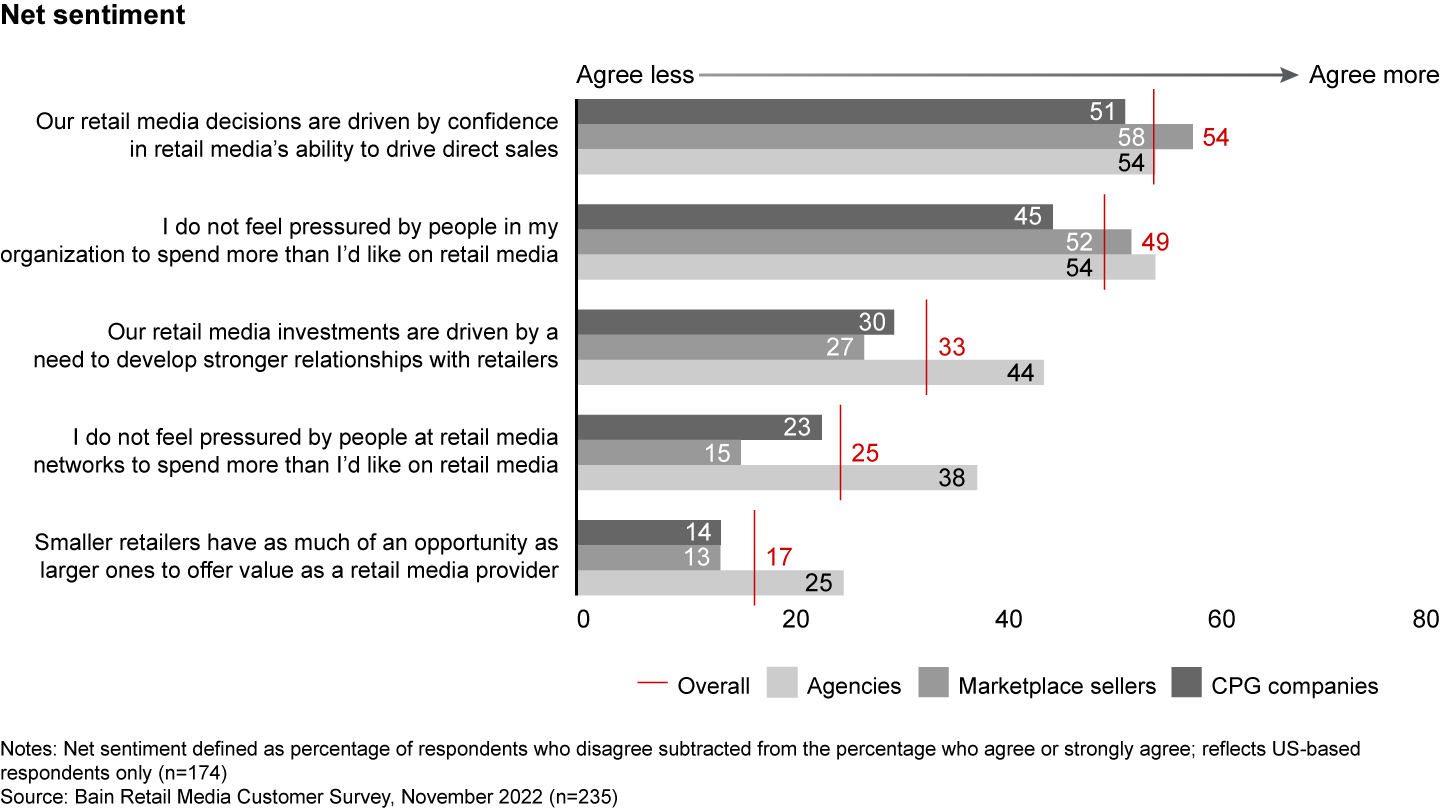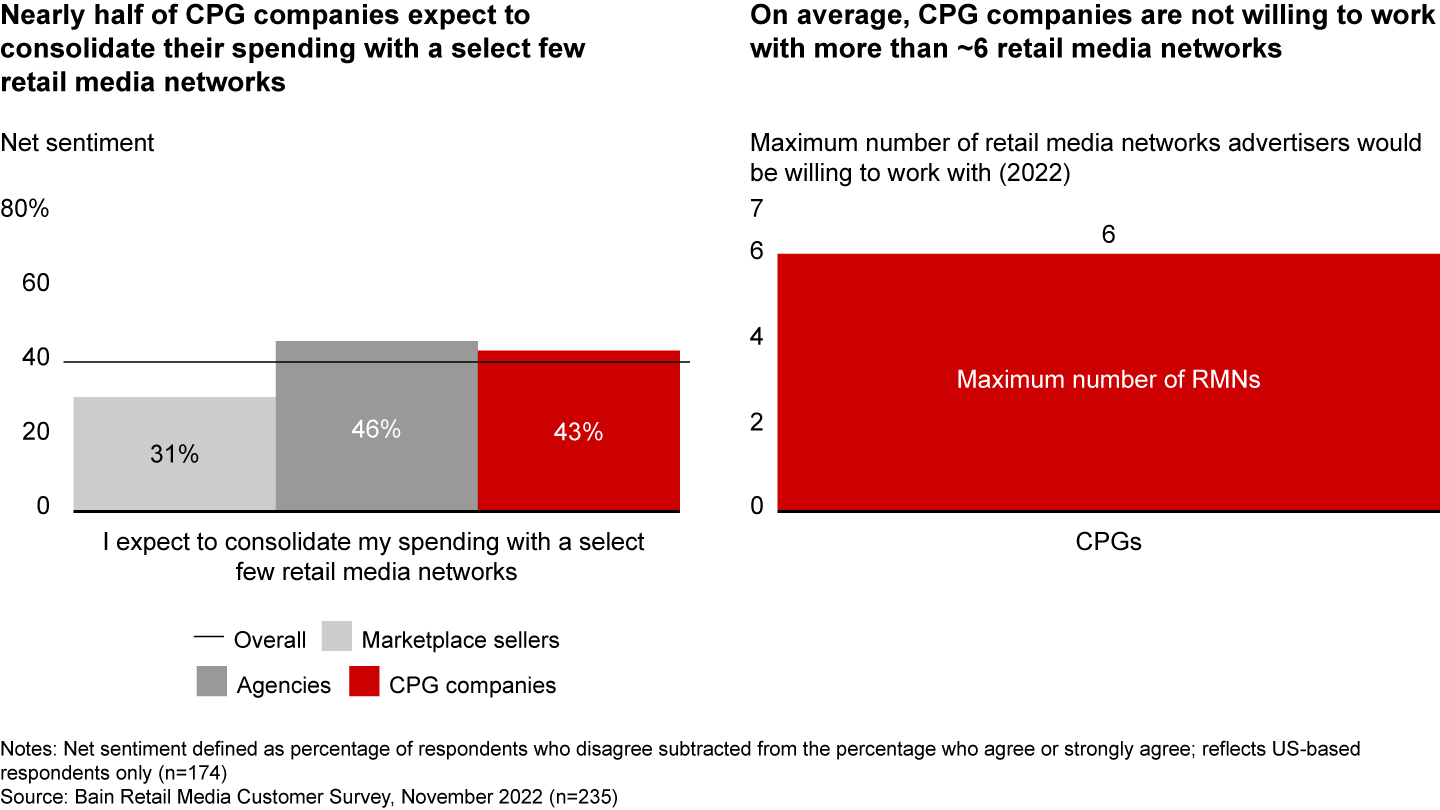
Retail media’s ascent shows no signs of slowing. The digital ad revenue channel has ballooned dramatically in the last four years and is forecast to grow 12% annually to about $140 billion in 2026.
The good news is that CPG companies can reap multiple benefits from this explosive growth: precise and personalized marketing with high conversion rates, a deeper understanding of the shopper journey, and a cost-efficient test-and-learn mechanism.
The bad news? The proliferation of retail media networks and the associated investment required to build them have overwhelmed both retailers and CPG brands. Many retail media offerings remain underdeveloped, and CPG companies’ sales and marketing teams are experiencing considerable tension regarding how to invest. Capturing the full value of retail media requires a clear-eyed view on what’s on the horizon—and how future developments will impact investment. We can help you navigate the array of decisions and craft a go-forward strategy that will ensure you make the right moves at this pivotal moment.
The rise of retail media
To understand where retail media is going, let’s unpack how we got here. The pandemic-fueled adoption of online grocery caused a step change in penetration, which is now settled near 10%. In the next decade, we expect to see a continued rise—with current estimates suggesting penetration as high as 13%—driven by younger shoppers’ embrace of e-commerce, growing platform sophistication, and a surge in innovation that will enhance consumers’ experiences online and in-store.
These growth trends have retailers keen to improve online business profitability (see Figure 1), which has become more of a challenge as e-commerce has swelled. In addition to improving basket economics and operations, retailers want to diversify revenue streams. Enter retail media networks. These platforms offer CPG companies smart interactions with the right consumers at all levels of engagement, access to rich consumer purchase and demographic data, and a flexible digital retail shelf with rapid feedback loops. While this trifecta can boost profitability, engaging with a rapidly evolving landscape poses several challenges.

What’s on the horizon
To decide where to lean into (or bow out of) retail media, CPG companies are keen to understand what’s coming down the pike. Given the attractive economics and low barriers to entry of retail media, we’ll see the number of networks grow and the possibility of near-term consolidation shrink. However, we believe the top five networks—Amazon Ads, Walmart Connect, Target’s Roundel, Instacart Ads, and Kroger Precision Marketing—will continue to own the lion’s share of the market (~60%), given platform sophistication, size (revenue), and scale (site visits and audience reach) relative to competitors.
Another looming question is just how big retail media will get as a percentage of total digital marketing spend. Today’s baseline is 17%, with almost 85% of that share invested in on-platform ads, or those appearing on a retailer’s own digital properties, such as sponsored search ads, email ads, and on-site display.
We believe that baseline of retail media as percentage of digital media will grow significantly. But on-site inventory is finite and opportunity-capped by e-commerce penetration; there are only so many online ads a retailer can serve a consumer before deteriorating the shopping experience. So increasingly, CPG companies’ investment into retail media is migrating to off-site ads—those appearing on other digital properties using the retailer’s data for targeting. These units are becoming more intriguing to the players seeking rich first-party data and closed-loop measurement.
More growth avenues ahead
A few more trajectories could fuel projected retail media growth. Media partnerships (such as Amazon and Thursday Night Football) may continue to proliferate, further increasing off-site inventory. Retail media pricing may also become more competitive with the shift away from managed service to direct purchase, thus eliminating the middleman (and associated service costs). This may propel CPG companies to develop more sophisticated internal measurement that they can leverage to negotiate pricing.
Lastly, retail media networks may very well deliver on the measurement promise. The death of cookies will further challenge media incumbents, while retailers will develop technology and process solutions to share valuable data with brand teams such as leveraging cleanrooms to anonymize protected consumer data and facilitate collaboration.
As this landscape evolves—and if the conditions above come to fruition--we expect retail media to nearly double its share of total digital marketing spend over the next two to three years (reaching 30%), likely tripling today’s share by 2030, reaching 50%.
Setting the target—and segmenting accordingly
What does all this this mean for CPG companies as they wade through a dizzying array of retail media options? They must identify goals and determine how to reach them. First, we guide brands as they define their ambition, which informs their funding model and thresholds across all commercial levers, such as trade, national media, and shopper marketing, inclusive of retail media.
With retail media unlikely to consolidate in the near term, we help companies segment their investment strategy to establish internal resourcing and spending guardrails. Two criteria are paramount:
- How attractive is the retail media platform? To gauge this, we look at revenue, monthly site visits, differentiated value propositions (e.g., unique audience segments), measurement capabilities, self-service functionality, and CPG companies’ assessments of retail media networks via the Net Promoter System℠.
- How attractive is the retail media partnership? Are CPG companies promised a high level of service from the retailer, including a dedicated support team and retail media joint business planning? Further, what is the retailer willing to offer in exchange for retail media investments?
Using this segmentation framework, most CPG companies funnel the majority of their dollars to the top five players, with more moderate investments in a targeted list of three to five platforms. According to a Bain & Company survey conducted in partnership with ROI Rocket, nearly 50% of the hundreds of US CPG companies polled said they expected to consolidate their spending, with most expecting to advertise on about six platforms (see Figure 2). Investing in too many at today’s level of sophistication would quickly overwhelm internal teams while delivering limited incremental value to the organization.

Accelerating the strategy
Once clients determine their investment strategy vis-à-vis segmentation, we help them optimize these investments and shore up the capabilities needed to execute their vision.
Leading CPG companies continually experiment to ensure each marketing dollar is working as hard as possible. Innovation often emerges from exploratory questions: Should we shift from brand to category budgets and campaigns? Are Amazon audiences worth it to drive mid-to-lower funnel outcomes? Should we use geo-location to complement in-store programming with retail media buys? We help clients stand up this experimentation muscle and build the internal capabilities to install and scale it.
Take measurement and analytics, for example. Most CPG companies lack the dedicated resources to effectively track and optimize their ever-expanding retail media budgets. A return on ad spend (ROAS) of 2.0 can mean very different things on Platform A vs. B, depending on the methodology used (such as in-store halo, product halo, or attribution window). In the absence of industry-wide standardization and ad regulation, winners focus on creating an internal guide for standardizing KPIs across platforms.
Given the scale and specificity of audience data, leading CPG companies extend retail media objectives beyond ROAS and conversion into brand-building. They track a broader suite of metrics like retailer share of search, purchase frequency, and brand engagement to guide investment decisions. We ensure they align KPIs to marketing objectives and educate teams on how to set targets and interpret results.
Finally, we make sure clients are continually executing against their highest-priority analytics use cases, such as linking inventory data with bidding strategies to redirect investments to where they have adequate supply. Importantly, we help them track the results of test-and-learn experiments to increase efficiency and effectiveness of ad investments.
Building the machine
It’s clear by now that retail media is here to stay. What may be murkier to organizations is how exactly they should evolve their internal operating models as retail media investments inch closer to half of a CPG companies’ digital marketing spending. After clients set their retail media ambition and begin to fill critical capabilities gaps, we ensure they build the scaffolding that will yield long-term success.
A typical retail media operating model journey might look like this:
- Starting point: Retailer-aligned shopper marketing resources plan and execute retail media with agency partners. There are connective threads to brand teams who own budgets, but strategy and execution are quite siloed by media type.
- Evolution 1.0: Strategy is led internally vs. by an agency. Retail media is incubated in a more central, cross-retailer team to build expertise, optimize data and investments, and drive consistent processes. This team adopts agile processes such as weekly stand-ups and sprint reviews to facilitate collaboration with both agency and brand teams.
- Evolution 2.0: Retail media is entirely housed in the brand—with all media budgeted, planned, and executed within one team. A lean central retail media backbone, often sitting in sales, delivers integral capabilities, supports emerging platforms, and serves as a critical liaison to sales teams.
Our goal as advisers is to help brands evolve their operating models to achieve two critical objectives: become intentional about building internal expertise on retail media strategy and execution, and foster greater collaboration and integration across sales and brand siloes.
Keeping pace with retail media’s rapid growth requires a clear understanding of how this dynamic advertising platform is evolving. As your partner, we offer a view of what’s ahead and then help you sharpen your ambition and investment strategy, accelerate it with platform optimization and capability building, and align your operating model to ensure you get the full value of retail media’s offerings.

